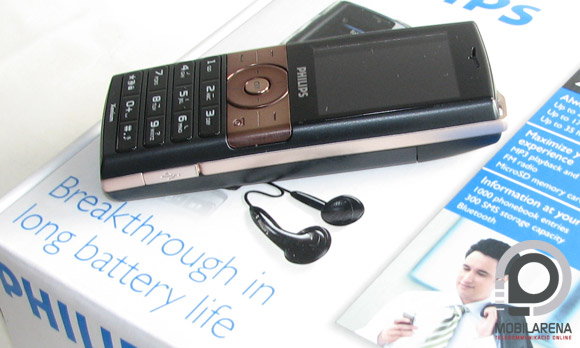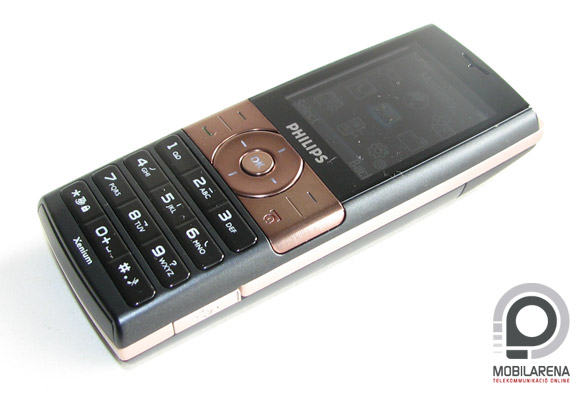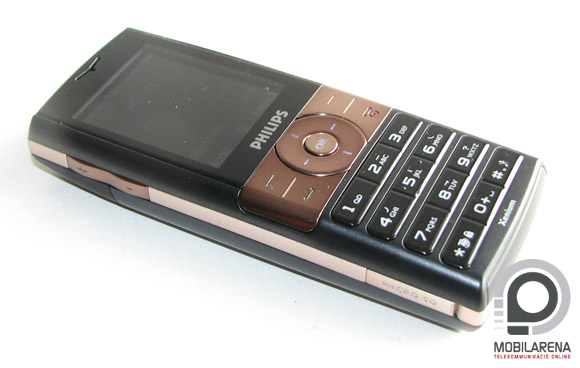Introduction
When we had a Philips phone in our hands last time… well, that wasn’t really good. My colleague Polacheck has been undergoing treatment at a sanitarium and had nightmares even years later. Now he has recovered and Philips has returned – at least into our country, as lately no handsets of the Dutch-Malaysian manufacturer have been available, even though once they had some great ones (Genie, Genie Sport).
But now, thanks to the effective intercession of XXL GSM we had to choose from tons of new Philips phones (so we will keep them coming), but first of all we have taken the phone that has been the subject of our news reports many times and it’s renowned for only one thing: it stays online for two months with one charge.
This is a bold thing to say, mostly because Xenium 9@9k is not a fully low-end handset, as it has a colored display, GPRS support, an MP3 player and expandable memory and these like to consume battery power. Of course it’s not an expensive phone; it currently costs about €75 EUR.
So we’re looking for answers for three questions. How do the current Philips products look like, does it really take it for two months without a need for charge and how can we speed up time to find this out. This last question is the toughest.
The wonder-battery
As an irregular step we’ll start the review with the battery, but if you have read the previous page I think you can understand this. I suppose I haven’t been the only one to be interested if the box of the small Philips is a liar or not. I would like to put it forward: we don’t have two moths to test a phone, so we had to look for another solution and this gave us some headaches.
Besides standby time there are two other parameters that are worth to be mentioned. It is told that the handset can play back music for 34 hours and the battery keeps it online for 17 hours if talking continuously. These are quite good times and quite large ones too, as such an average phone usually goes dead after 3-4 hours talk.
But who the hell should I call for 17 hours? Even if we don’t consider the phone bill (even though we have free calls in the group): should I call someone and ask him: “Hey, do you have 17 spare hours?”. Even if he or she would have – he doesn’t have a Philips phone, that’s sure. So I had the usual method of using the Philips as my own phone for a week and this had a really surprising result.
I have fully charged the 1850 mAh battery by Tuesday morning and I have set off exploring the battery’s power. I have called someone who I haven’t spoken to for a long time so we had a lot to talk about. After two and half hours his phone’s battery went offline, Xenium’s battery indicator didn’t move an inch. By the end of the day I have been talking for six hours on the damn phone and according to the display the battery was still full. By Saturday evening one stroke finally disappeared, but by then I have been at about 10 hours of talk time and at Sunday evening (when writing this review) charge level was still about 60%.
As for me I really believe that this phone can take 17 hours of talk and although I’m not sure about the two moths of standby time, but this performance is still much better than any other phone’s. What’s the secret? The battery is powerful, Philips uses their own chipset, which is optimized to their liking. 9@9k doesn’t have less features than any other similarly priced phone, they are just paying attention. And for Christ’s sake, any other manufacturer could do this if they would just care about it.
Exterior
The design is no big hit, it somehow reminded me of Sony Ericsson V640i in some places, but maybe just because of the colors. Xenium 9@9k is a bit narrower and chubbier than an average phone, but it’s good to keep in the hand, although it gives the impression of a cheap phone.
Everything’s made of plastic, if we keep pressing it hard then we can hear some cracks, but nothing’s hanging or bends on it, it’s a good phone for this amount of money. The key layout is simple, logical, the round navigation button can be used easily too. There is a bronze-colored stripe running along the side of the phone and it forms a small loop in the top right corner – this is for the neckband. On the left there are the volume control keys, while a bit below there is the microSD slot. On the right there is another cover protecting the standard miniUSB connector.
The stereo headset (included in the package) has to be plugged here too, and although there is no data cable included, but I think that every second household has at least one USB-miniUSB cable if that household has ever owned a digital camera, a Motorola phone or maybe a high-quality MP3 player.
The back is a simple, puritan piece of plastic, there is a hole on it for the camera and a gap for the speaker. The display has a resolution of only 128 x 160 pixels, but it’s fortunately a TFT.
Menu, basic functions
So, until now everything’s rather fine, but – remembering the interior of the last Philips models we have taken a look at – it does matter quite a lot how much does the menu system differ from the usual schemes, did they install a too unique interior or features assembled by Malaysian logics. Fortunately this is not the situation, and although there are some strange things, but on the whole the software is quite okay.
There is a main menu with nine icons, and although I’m still disgusted by these light graphics on a dark background (maybe there would have been a better chance to read the screen in sunlight if these were inverted), but the guys at Philips won’t confuse anyone who has been used to Nokia handsets for example. Let’s put it forward: there are no themes, we have to get used to this color scheme. The menu, however, has horizontal tabs at many places (this is a smart thing), and even more the handset is surprisingly fast, there are no lags, so they have highly optimized the software to the hardware or they have used a fine CPU.

There are flaws, however. It’s a great thing that there are profiles, it’s also good that we can set screen brightness, but I have been angered by the “meeting” profile having minimal backlight by default, so I had to go to a darker room in order to switch back everything to normal. I have been looking for hours for the call log, but this doesn’t exist, we can’t have look at call durations; neither separately, nor in a unified view. Still the phone displays call time during conversations, but later on we can never have a second look at this information.

The phonebook looks fine at first, as it can store 1000 contacts and we can even attach really tons of information to a contact. This includes: name, cellular number, home number, office number, fax, email, website, image, ringtone, group, county, street, postal code, city, country, note. The software can display SIM and internal memory contents on the same list, but it couldn’t recognize the last 50 entries from the 250 on my SIM card and I couldn’t explain why did this happen.
I have been afraid a bit of messaging as in case of an exotic handset – at least in this country – I usually get all kinds of stupid encodings, key layouts and predictions, but there are no serious problems here. The internal memory can store 300 SMS messages and text entry is surprisingly simple, special characters appear in a table when pressing the * key, just like on an Alcatel. I had no problems setting up MMS, the system has a size limit of 300KB, which is more than enough. There is no email client, but we shouldn’t expect everything for this price.
PIM functions, games
The calendar launches in moth view but it has graphical week view too. We can store one kind of entry, this can have a name, a place, a begin time and an end time and we can set an alert to it. There are two kinds of alarms: the single-time and the repeating, in this case we can set the days of the week when it should go off.

The calculator has a very lame design, although if I would be a marketer I would surely say that it’s characterized by functional simplicity. The world clock isn’t bad, we can select two time zones (home and abroad) and these can be set up on a nice map. After this the times of both time zones get displayed on the standby screen. The stopwatch, the countdown timer and the currency converter don’t bring much new, but it’s great that they are included.

It’s a rare thing for phones to have call filtering at phone level. This feature is included under the name firewall. It is very simple, we just have to define the numbers we want to be filtered and after this we can set if we want to deny calls, SMS messages or both from the set numbers.
I have found another interesting feature, as the voice recorder is a very much emphasized feature. On one hand it records the voices of both parties during a call, but Philips engineers have considered this situation so frequent that pressing the OK key during a call immediately starts recording. The length of the recording depends only on us, as the handset can record to the memory card as well.

There are three games, all three of them are very primitive. A tetris, a snake and a box-pushing thingy are all. There is no Java support and this really hurts.
Multimedia
Yes, it has a camera. Powerful VGA resolution, 20-30 kilobyte large images, so you can imagine quality. Taking pictures is of course a very fast process, the phone emits a loud clapping sound when taking the shot, so we can scare the person we’re taking the picture of. Of course when we copy the images to a computer we can see that this is not the most important feature. You can see some great photos below.
The musical part is a bit better, we can even read on the box: 34 hours of continuous playback without charging. I have to believe this due to the reasons I have mentioned above, but unfortunately we don’t measure music playback quality in hours. The software is a rather simple one, theoretically it can display album covers, but I didn’t manage to do this. The tracks are sorted by ID3 tags, Just as usual.
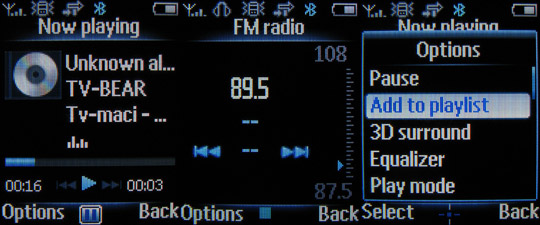
Sound quality is terrible without a headset. It’s distorted, it cracks, it hisses… we shouldn’t use it this way. I have tried to tamper with the equalizer presets, but these had no effect. This made me take the headset in my hands, but this has been a mistake. This doesn’t affect quality much, it has improved a bit, but sound tone… and then I have enabled 3D surround mode, but this didn’t change anything at all either. No problem, I’ll keep listening to it a bit longer, until then I’ll put it in the background – but this cannot be done, music stops instantly. It’s a pity.
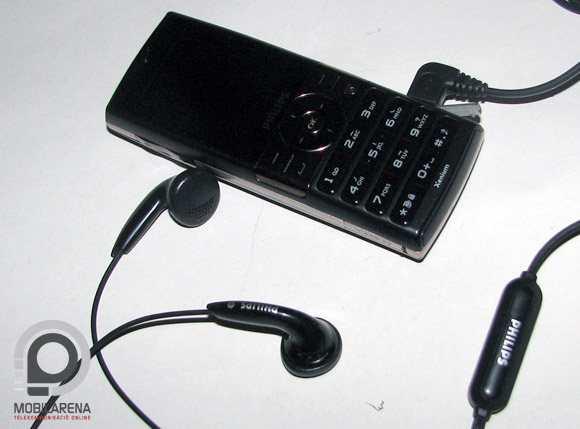
The FM radio could have compensated for the disappointment, as reception quality is surprisingly great, but there is no RDS support, so channels have to be stored manually, but at least this can run in the background.
Data transfer, summary
GPRS is the fastest mobile data transfer technology supported by the little Philips. With this, and with the 1.8” display the designers weren’t really forcing some browsing experience, as there is no HTML browser in the phone, we should stick to WAP if necessary.
There is, however, Bluetooth support, even if not stereo, but it worked perfectly for data transfer and there is USB connection, which can provide USB Mass Storage mode, so the operating system will see the memory card as an external drive. 9@9k won’t work as a modem and we can’t access the internal memory, but since this is 3 MB large, we won’t really need it.

I think we have talked enough about the battery, it’s really shocking. Let’s sum it up. Here is an old manufacturer, which hasn’t been present in our country for years. Now it has become available again, although the test phone had only English, Chinese, Indonesian and Vietnamese languages. Its price will be around or below €75 EUR and there is one thing in which it is simply the best: standby time. If I don’t consider this, the small Philips is still not bad: it has Bluetooth, microSD, MP3 player, camera and a colored display, many of my friends have told me that they would like it as a secondary phone.
Because of its battery and everything else, Philips Xenium 9@9k is:
 |
| Philips Xenium 9@9k |
Bog
Translated by Szaszati
Philips Xenium 9@9k has been provided by XXL GSM.
The handset can be purchased at:
Budapest VI. Jókai tér 6.
Specifications
| Philips Xenium 9@9k | ||
 | General | |
| Technology | GSM | |
| Size | 104.3 x 42 x 18.7 mm | |
| Weight | 108 grams | |
| Available colors | Bllack-bronze | |
| Display | ||
| Display diagonal | 1.8” | |
| Display resolution | 128 x 160 pixels | |
| Display type | TFT | |
| Number of colors | 65 thousand | |
| Memory | ||
| Phonebook capacity | 1000 entries | |
| SMS memory / max. MMS size | 300 / 300 KB | |
| Internal memory | 3 MB | |
| Memory expandability | microSD (max 2GB) | |
| Data transfer | ||
| Frequency bands | 900/1800/1900 MHz | |
| GPRS / EDGE | present / none | |
| UMTS / HSDPA | none / none | |
| IrDA / Bluetooth | none / present | |
| WiFi | none | |
| USB | present | |
| Push-to-talk / RSS | none / none | |
| GPS receiver | none | |
| Basic functions | ||
| Profiles | present | |
| Vibra function | present | |
| Built-in handsfree | present | |
| Voice dialing / voice commands | none / none | |
| Sound recorder | present | |
| Alarm clock | present, also when turned off | |
| Predictive text entry | T9 | |
| Software | ||
| Platform | Philips proprietary | |
| WAP / HTML browser | 2.0 / none | |
| E-mail client | none | |
| Java | none | |
| Games | 3 (Snake, Tetris, Boxman) | |
| Currency converter | present | |
| Extra software | - | |
| Multimedia | ||
| Main camera | VGA, fix focus | |
| Secondary camera | none | |
| Video recording | present, SQCIF, 15 fps | |
| Music player | present | |
| Equalizer | present | |
| FM radio | present | |
| Battery | ||
| Main battery | 1850 mAh Li-Ion | |
| Standby time | 1440 hours | |
| Talk time | 17 hours | |
| Other | ||
| - | ||
